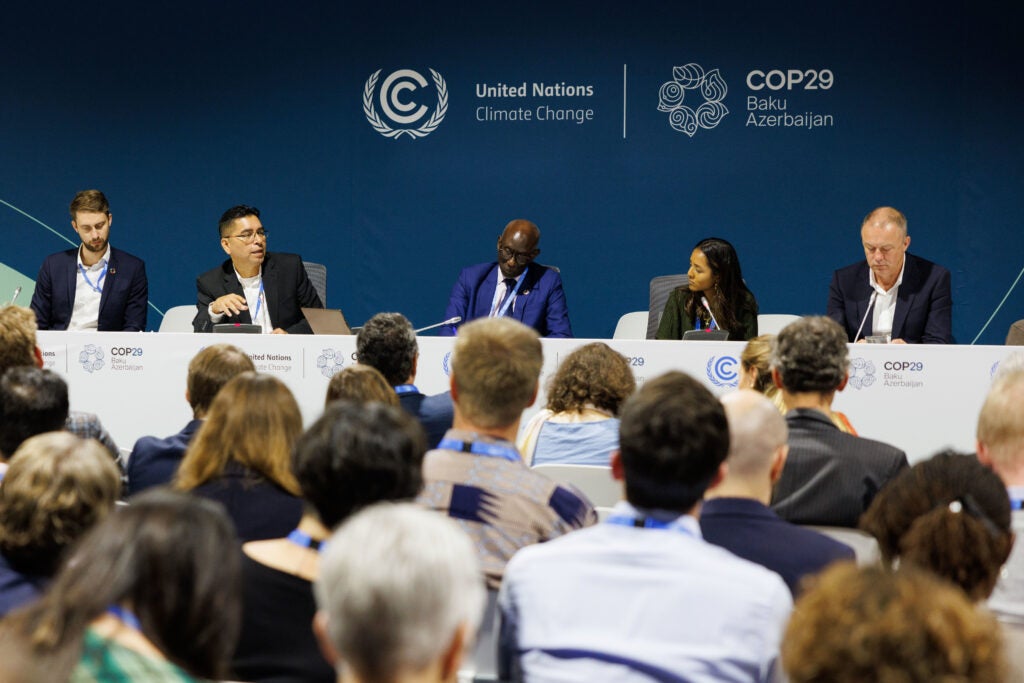Results were released today for California’s fourth cap-and-trade auction of the year, which was administered last week by the California Air Resources Board (CARB). Auction prices in the joint California-Quebec market (known as the Western Climate Initiative, or WCI) have trended downward this year, reflecting growing uncertainty among market participants about how best to plan their compliance strategies in the absence of regulatory or legislative clarity. A clear commitment to ambitious reductions in climate pollution and long-term market stability are urgently needed.
Climate 411
California auction results underscore need for ambition and certainty in cap-and-trade market
Effective participation and engagement of Indigenous Peoples and Local Communities at COP29

Juan Carlos Jintiach from the Global Alliance of Territorial Communities, speaking on direct access to finanance for Indigenous People at COP29. Photo by Bärbel Henneberger.
This post was authored by Bärbel Henneberger, Senior Partnerships Manager at the Environmental Defense Fund.
On November 21, COP29 celebrated Indigenous Peoples and Local Communities (IP and LCs) as a thematic day in the Action Agenda of the Azerbaijani COP presidency. The day underscored the essential role of IP and LCs in safeguarding 80% of the world’s biodiversity and preserving 36% of intact forest landscapes.
To succeed in the fight against climate change, we must collaborate with IPs and LCs and respect their principles, culture, and methods while providing the support they need to further our shared conservation goals. We won’t succeed in conserving tropical forests without the partnership and leadership of IPs and LCs.
Climate conferences like COP29 offer a platform for IP and LCs to amplify their voices, and shape negotiations. It’s an opportunity for them to show the world how their efforts to conserve and sustainably manage their territories, which are some of Earth’s most important ecosystems, are critically important in the climate fight.
At COP29, IP and LC delegates spotlighted examples of effective participation in negotiations, policy frameworks, and innovative climate finance mechanisms. These efforts, though diverse, share a common goal: to embed Indigenous rights and knowledge systems into global climate action. Below are a few examples of Indigenous approaches to conservation efforts showcased during COP29. Critically, the world must continue to support, and learn from, these approaches well after the negotiations in Baku have ended.
Spotlight on LCIPP and the IP Caucus
Climate Finance and Accountability at COP29

COP29 sign in Baku. Photo by UNclimatechange via Flickr
Today, November 14, is Finance Day at COP29. We caught up with Leslie Labruto, EDF’s Managing Director for Sustainable Finance, about what she’s watching for at COP29, the United Nations’ climate change talks in Baku, Azerbaijan. Follow Leslie on LinkedIn.
Q: You’re in Baku for COP29. What key issues are on your radar?
A: The spotlight here this year is on scaling up climate finance for developing countries, and a need for redoubled global cooperation to achieve our shared climate goals. My team and I, along with the rest of the +Business team at EDF, are laser focused on working with the private sector to ensure climate and nature wins. A major focus at COP will be the establishment of a climate finance goal, called the New Collective Quantified Goal (NCQG), which will replace the $100 billion annual commitment that high-income countries pledged to deliver under the Paris Agreement. The NCQG could reach at least $1 trillion a year—a figure that better aligns with the financial gap that needs to be closed to address the climate crisis.
Developing countries need these funds to tackle climate change, transition to clean energy, and adapt to the impacts of climate change, and it’s crucial that the finance be provided in a way that’s just, equitable, and effective. Let’s not forget that those ‘wins’ in developing countries are good for everyone everywhere, since climate impacts are felt globally. Successful climate finance means more forests still standing, a larger climate workforce, more resilient food systems, more methane abated, and greater global renewable energy capacity. Because climate-related investments are needed to meet global goals and address inequitable impacts from past emissions, low-income borrowers should have access to concessional finance. The NCQG will not only scale up ambition but also support countries as they prepare to submit their updated climate commitments in 2025.
Q: You’ve emphasized both the quantity and quality of climate finance. What do you mean by “quality”?
A: While the amount of climate finance is essential, its effectiveness — its quality — is equally important. When we talk about quality, we mean ensuring that climate finance is structured to be concessional, accessible, and impactful. In the private sector, finance is tracked with metrics like profits and losses that communicate shareholder value. In climate finance, however, there is less accountability in terms of impact metrics.
Climate finance should leverage public and private investment to make rapid progress toward net zero emissions and benefit local communities. To make sure financing achieves this, we need a system that is accountable for being easy to access, impactful in tackling climate-related challenges, and affordable for borrowers.
At COP29, Article 6 must deliver on urgent finance for forests and Indigenous communities
This blog was authored by Pedro Martins Barata, Associate Vice President, Carbon Markets and Private Sector Decarbonization and Santiago García Lloré, Senior Manager, IPLC & Conservation Partnerships, Forests
At the start of COP29, negotiators in Baku secured a major breakthrough by agreeing on new standards for a UN-led global carbon market under Article 6 of the Paris Agreement, potentially unlocking billions in funding for climate projects.
But the terms of the standards are still flexible, meaning there’s a real chance to shape them to make sure the money goes where it’s needed most – like Indigenous Peoples and local communities who are fighting to conserve the planet’s last intact forests, known as high forest, low deforestation (HFLD) regions.
The stakes are higher now than ever, especially after the recent US election, which casts doubt on future public climate funding from one of the world’s biggest economies. In this uncertain landscape, carbon markets must step up to fund critical climate solutions, especially nature-based projects like forest conservation.
Growing costs of climate emergency demand ambitious policy — not business as usual
Fear, uncertainty and doubt are frequently-used tools to undermine environmental policy. For decades, polluters and their sympathizers rejected the existence of climate change. Now, they say climate action costs too much. This recurring argument ignores the costs working Californians are already facing from a changing climate and the clear benefits of California’s climate policy in order to justify “business as usual” for the biggest polluters.
Californians rightly want to understand fluctuations in day-to-day energy prices, but debates over these issues cannot conveniently ignore the significant costs of climate inaction, its impact on our cost of living and its disproportionate impact on families with low incomes.
- A national report ranked California the worst state for natural disasters fueled by a changing climate, with expected annual losses totaling more than $16 billion statewide
- Home insurance is harder and more expensive to get. Seven of California’s largest property insurers, State Farm, Allstate, Farmers, USAA, Travelers, Nationwide and Chubb recently limited new homeowners policies in the Golden State — raising questions about the stability of the California home insurance market.
- During an 11-year period, exposure to wildfire smoke caused more than 50,000 deaths in California and more than $400 billion in economic impacts.
- During seven extreme heat events over the past decade, California experienced $7.7 billion in losses.
New modeling shows the power and potential of cap-and-invest in Washington state
Washington state’s cap-and-invest program, created in the 2021 Climate Commitment Act (CCA), is nearing the end of its second year and has already raised over $2 billion for communities by putting a price on pollution.
The program is a win-win for climate action and for communities: It creates a powerful economic incentive for companies across the state to lower their emissions, while generating investments for Washington communities in the process. There are already many projects underway across all 39 counties in the state, putting that auction revenue to use. Some of the benefits that people in Washington are seeing include:
- More access to cleaner public transit including free ferry, bus, and other transit rides for youth.
- Cleaner air for children in and around schools with upgrades to zero-emissions school buses and new, efficient HVAC systems.
- Lower energy bills for low-income households and small businesses who receive support for replacing old gas furnaces with modern and efficient electric alternatives.
But the scale of this program enables it to deliver much more for Washington’s communities and economy in the long run. Just how much more? Thanks to new, in-depth modeling from Greenline Insights, supported by EDF, we now have a clearer picture of the transformative impact this program could have.













